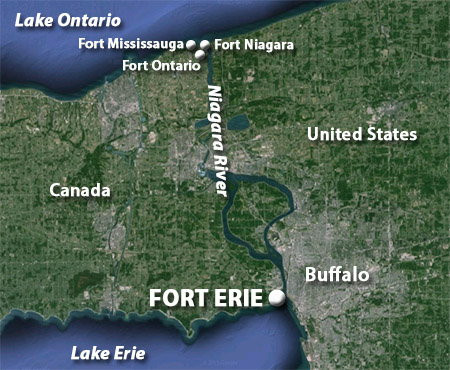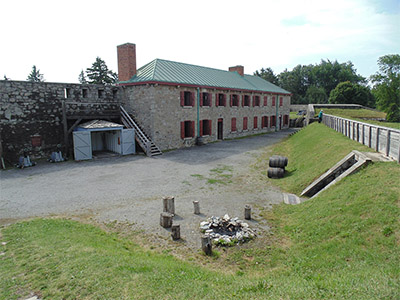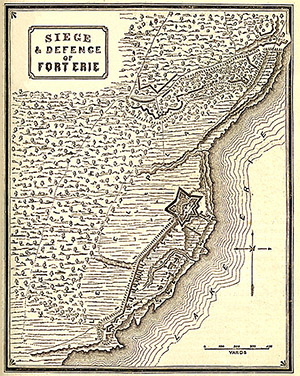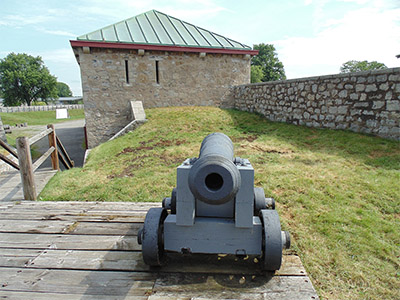 |
Fort Erie
Fort Erie, Ontario, Canada
|
|
 |
Constructed: 1805-1807
Used by: Great Britain,
United States
Conflict in which it participated:
War of 1812
|
Fort Erie is the location of the bloodiest battle to take place on Canadian soil, in which over a thousand British troops lost their lives in an attempt to recapture the fort from the invading US Army, during the War of 1812.
The area that is today the town of Fort Erie was a resource for Onondaga flint, which was used to make tools and arrowheads by the Iroquois for thousands of years, before the French showed up in the 17th century.
|
 |
 |
|
The French built the Maison a Machicoulis on the upper reaches of the Niagara River in 1629, which would eventually be expanded to become Fort Niagara. The French and Indian War (1756-1763) resulted in the vast majority of the lands the French had claimed over the previous century being ceded to Great Britain, which had an immediate interest in fortifying its new lands...with starforts? Unfortunately not at first, but with nice, cheap blockhouses. |

Looking towards Fort Erie's southern bastion, across one of its two beautiful interior barracks. The interior of the fort is cleverly separated by a tall berm, which would protect the interior buildings from an enemy that had penetrated the fort's western half. |
 |
The first attempted Fort Erie, a wooden blockhouse with a series of support buildings, was built by the British in 1764. This fort was used as a supply base for British troops, loyalist forces and their Iroquois allies during the American Revolutionary War (1775-1783). Built too close to the punishing waters of the Niagara River, this fort was done in by the frigid weather for which the region is justly famous: Flooding and ice rendered the fort unusable in 1779.
A new blockhouse, featuring the technologically advanced building material known as stone (likely the local Onondaga flint), was built at the same spot in 1783, with the predictable result of storm damage destroying it in 1803. |
|
|
The third and final iteration of Fort Erie was begun in 1805 at a slightly different location, not quite as close to the river. This lovely angry-butterfly style of starfort was incomplete by the start of the War of 1812 (1812-1815), but was finished in 1812.
Aware that an overwhelming force of American troops were on their way to Fort Erie in May of 1812, the small garrison of British and Canadian troops partially dismantled the fort before withdrawing, leaving the Americans a starfort so messy that they left in disgust on June 9, whereupon the fort was reoccupied and repaired by the British.
|
Flags a-flyin', the US Army returned to Fort Erie, chased off its perpetually small garrison (the fort mounted a mere six cannon) and captured the fort once again on July 3, 1814. The Yanks expanded the fort and used it as a supply base as they charged into Canada, hoping to win a decisive victory before Britain's professional, veteran troops, freed from European responsibilities by the defeat of Napoleon (1769-1821), could make it to Canada.
The subsequent battles of Chippawa (July 5, 1814) and Lundy's Lane (July 25, 1814) were both arguably American victories, but the force under General Winfield Scott (1786-1866) suffered so many casualties that it was now outnumbered and unable to continue its heroic drive into Canada, and thus fell back to Fort Erie.
The British, under Lieutenant General Sir Gordon Drummond (1772-1854), beseiged Fort Erie through most of August and September of 1814. After an amazing British capture of two of the three US warships on the river, and repeated attempts to storm the fort (one effort resulting in 300 British dead in an instant, when a powder magazine exploded), Drummond, ultimately unable to recapture of Fort Erie, raised the siege and left.
|
 |
 Siege and Defence of Fort Erie Siege and Defence of Fort Erie |
|
Over 1,000 British soldiers died in the attempts to storm Fort Erie, making it the deadliest battle in Canada's history. In November of 1814, with winter approaching and word of British attacks on the United States' eastern seaboard, the remaining American troops destroyed what they could of Fort Erie and paddled back to the US. Great Britain occupied the greatly diminished Fort Erie until 1823, whereupon it was abandoned.
|

Fort Erie's southern bastion. |
 |
The Fenian Brotherhood, a body of individuals who were committed to breaking the wicked chains of Britain's hold over glorious Ireland, weirdly invaded into Ontario from Buffalo on June 1, 1866. Their ultimate intent was to seize enough transportation assets in Canada to force the British to trade Ireland's freedom for possession of Canada (?!).
Bolstered by some 500 US Civil War veterans, the Brotherhood took up residence at the ruins of Fort Erie, from whence they demanded food and supplies from the local populace, who were, perhaps predictably, displeased by this circumstance. |
|
|
The Fenian Brotherhood marched around for a bit and defeated a Canadian force at the Battle of Ridgeway (June 2, 1866), but retreated back to Buffalo when their their reinforcements were arrested and their supply line interrupted by an unamused US government. While the actions of the Fenian Brotherhood seem pretty misguidedly comical today, Canada did become an independent nation in the year following the Fenian invasion.
|
Beginning in 1937, Fort Erie was reconstructed to its War of 1812 appearance, and was officially opened to the public on July 1, 1939. During the reconstruction process, a mass grave containing 150 British officers and men, and three of the fort's American defenders during the siege of 1814, was found on the fort's grounds. These bodies were reinterred beneath the monument you might be able to see to the right.
 |
 |
Interpretive guides, dressed in War of 1812-period uniforms, began stalking the fort's grounds in 1967. Since 1986, an annual reenactment of the Seige of Fort Erie has taken place during the second weekend of August, which I stupidly managed to miss when I visited the starfort of our current interest one weekend too late in August of 2015...but at least I got to wear a cool hat. |
|
 |
|
|
Should you be interested in seeing more of what Fort Erie looks like today, perhaps you might visit our Fort Erie page in the Starforts I've Visited section.
|
|
|
|
|
|
 |




